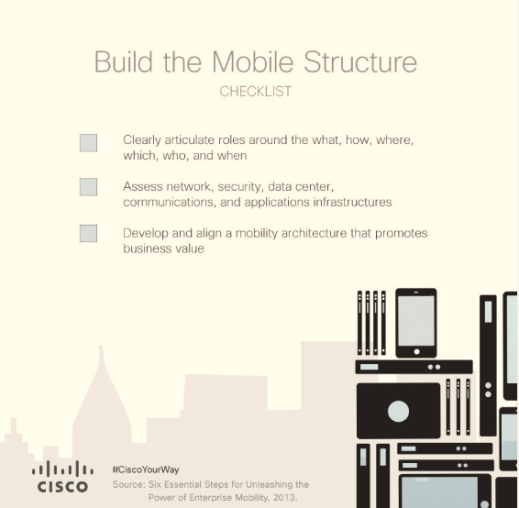Over the last several years, the role of an enterprise workforce has evolved from a select few mobile-enabled employees to a robust, global network equipped with advanced capabilities at their fingertips. As this workforce grows and evolves, how can enterprises, specifically their IT departments capitalize on opportunities available through mobility while meeting their ever-increasing workforce expectations?

Today we are launching a blog series featuring Vine-format videos that will highlight key insights from a recent Cisco whitepaper, “Six Essential Steps for Unleashing the Power of Enterprise Mobility.” In the coming weeks, we will be examining each step enterprises can take to enable new and more efficient ways of working in today’s mobile world. Today’s post highlights the first phase – How enterprises can build a mobile structure. Just as any building project should begin with efficient planning, here is a quick checklist to guide your own mobile strategy development:
1. Clearly articulate roles around the what, how, where, which, who and when.
For many enterprises, planning can take a back seat as increased mobility keeps IT departments reacting to the influx of requests for mobile devices to receive wireless access. Too often, enterprises can find themselves focusing on only one aspect of mobility. For a system-wide approach that keeps application performance, security and rich experiences top-of-mind, enterprises must develop a comprehensive mobile strategy.
As part of the planning process, enterprises should evaluate what mobility can do for the organization and articulate the what, how, where, which, who and when of the strategy. In a recent IT benchmark study of 200+ IT Organizations by Nemertes, 80% of organizations said having clear roles and responsibility and processes are critical to making their IT Operational model more successful. Some good questions to ask include:
- What are the challenges faced by your IT organization and employees?
- How can mobility help you solve these problems?
- Where will the mobility solutions be used?
- Which user groups need them, and which applications are required to keep them productive?
- Who will manage them?
- When do you want or need to deploy them?
In addition, once enterprises determine what to do, they should take the time to determine what not to do, because this can strongly influence the mobility architecture they choose to deploy. Regulatory, compliance, and security groups will be strong contributors here and throughout the process. Enterprises can also look to business use cases to support objectives for the overall strategy.
2. Assess Network, Security, Data Center, Communications, and Applications Infrastructures
An important part of the planning process should include an assessment of existing architecture. It will have a significant effect on the mobility architecture design and how it will evolve over time. It is essential to evaluate the following domains:
- Network infrastructure to make sure it can deliver optimal application performance and a positive user experience
- Security infrastructure and policy management to make sure of robust security across user, network, device, data, and application layers in support of enterprise, organizational, and regulatory compliance policies
- Data center infrastructure to make sure network, compute and storage resources are virtualized and can be scaled to support users and applications effectively
- Communications infrastructure to determine if it can support high-quality voice and video
- Application infrastructure to make sure it can support advanced collaborative capabilities such as unified communications and web-based video conferencing can be extended to any device, anywhere
3. Develop and Align Mobility Architecture That Promotes Business Value
Once a mobility strategy is established and infrastructure options are evaluated, enterprises can determine an appropriate architecture that will promote business value around the stated goals. This approach will prevent enterprises from taking an IT path that the business will not support. With budgets shifting from IT to Lines of Business (LoBs), it is more critical than ever that the IT is aligned to the LoB needs. As enterprises develop a mobility strategy, it is vital both business and technical teams define and prioritize what business goals will be enhanced or enabled by mobility.
For more information about building a mobile structure, an expanded checklist is available in the Cisco whitepaper, “Six Essential Steps for Unleashing the Power of Enterprise Mobility.” And here is where you can go for more information on Cisco’s Mobility solutions.
I look forward to discussing the second step enterprises can take on their path to unleashing the power of mobility in my next blog post. Meanwhile, please post your comments and let me know what successful steps your organization has taken to build a secure, scalable, and reliable mobile infrastructure.


CONNECT WITH US